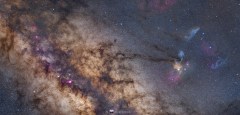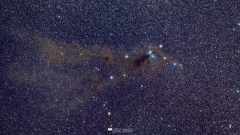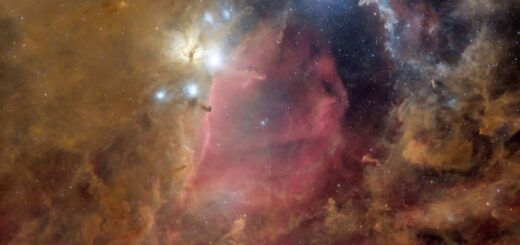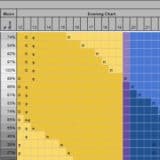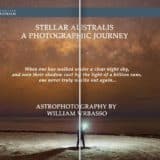Widefields of Antares and Corona
by admin · August 14, 2018

Two and a bit hours’ drive north of Perth there is a small nature reserve near Regan’s Ford with some of the darkest skies you can get (second only to the middle of the outback in my reckoning). Whilst camping is prohibited in the reserve (great to keep away tourists), there is nothing prohibiting my nocturnal hobby since I would be up all night taking photos.
This night was dedicated to doing some widefield photos. First up was a multi-panel image from Antares to the Milkyway core taken through a 50mm lens. This is a popular composition, taking in the Antares and Rho Ophiuchi nebula, the streaming tendrils of the dark nebula that seems to trail from Antares towards the core, and obviously the core and the multitude of bright nebulas that are embedded in its dusty plane (such as the Lagoon and Trifid nebulas). I took multiple length exposures for each panel, with the longest being 8 minutes. Whilst the end result looks reasonably good (“DSLR astro images” facebook group picked it for their header for a while), I have since determined that 8 minutes through this lens is needlessly long and a better result may have been obtained by stacking more shorter length exposures.
Can you spot the comet C/2018 N1 NEOWISE discovered only last month in July? I did, and knowing that no comet was supposed to be there I thought maybe a new discovery. Alas, the NEOWISE telescope found it a month before I did. Missed it by "that much".
Whilst doing the longer exposure runs, I also set up in parallel my stock Canon 6D with a 14mm ultra-wide angle lens to practice my timelapse photography (which I admit I consider only a secondary activity to my still photography). Mounted on a Syrp timelapse panning mount, I got a short clip of the night sky and Milkyway wheeling overhead – with the odd flash of light in the background from me revising my camera settings and going in and out of the 4wd.
With the night growing old, I attached a 200mm zoom lens to shoot the nearby constellation of Corona Australis (or southern crown). Within this constellation is a large dark nebula that nicely fits within a single panel of the 200mm lens. Again I took multiple length exposures with the longest being 8 minutes.
Its ok, but stars are a bit saturated – again I’ll try stacking more shorter length exposures instead.
After that I packed up all my equipment and headed home in the early hours of the morning. After all there’s no camping at the reserve, and I’ve heard that some rangers take a dim view of anyone sleeping in their cars in nature reserves.

